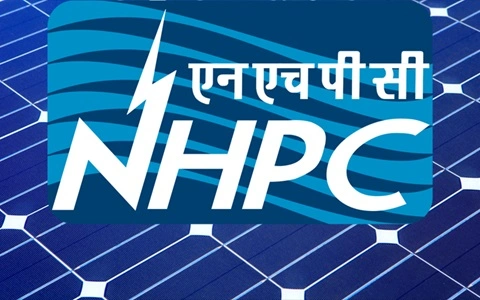NHPC Limited, formerly known as the National Hydroelectric Power Corporation, is one of India’s largest hydropower companies and a key player in the country’s renewable energy sector. Established in 1975, NHPC has grown to become a major public sector enterprise under the ownership of the Government of India. The company specializes in generating electricity through hydropower projects and has also diversified into solar and wind energy. NHPC plays a crucial role in meeting India’s energy demands and contributing to its renewable energy goals. This article delves into NHPC’s business model and explores how it earns revenue.
1. Overview of NHPC’s Business Model

NHPC operates on a B2B (Business-to-Business) model, where it generates electricity and sells it to state utilities, power distribution companies (DISCOMs), and other bulk buyers. Its business model focuses on:
- Hydropower Generation: Developing, operating, and maintaining hydroelectric power plants.
- Renewable Energy Diversification: Expanding into solar and wind energy projects.
- Long-Term Power Purchase Agreements (PPAs): Ensuring a steady revenue stream through fixed agreements with DISCOMs.
- Project Consultancy: Providing consultancy services for hydropower and renewable energy projects in India and abroad.
NHPC’s focus on sustainable energy generation aligns with India’s commitment to achieving net-zero emissions by 2070.
2. Revenue Streams
NHPC generates revenue through multiple channels, primarily revolving around power generation and related services:
a) Sale of Electricity
The primary revenue source for NHPC is the sale of electricity generated from its hydropower plants. NHPC generates electricity and sells it to state utilities, DISCOMs, and other bulk buyers under long-term PPAs.
Revenue Model:
- Revenue is earned based on a cost-plus-tariff model, where NHPC recovers its costs (capital expenditure, operating costs, etc.) along with a fixed return on equity (ROE) as determined by the Central Electricity Regulatory Commission (CERC).
- Fixed charges: Earned even if the buyer doesn’t use the allocated power, ensuring steady cash flow.
- Variable charges: Based on actual electricity consumed by the buyers.
b) Renewable Energy Projects
NHPC has diversified into solar and wind energy to align with India’s renewable energy targets. The company is developing grid-connected solar and wind projects across the country.
Revenue Model:
- Earnings from the sale of electricity generated from renewable energy projects.
- Participation in government auctions and renewable energy certificates (RECs).
c) Project Consultancy
NHPC offers consultancy services in the development, construction, and operation of hydropower and renewable energy projects for other organizations.
Revenue Model:
- Fees for feasibility studies, design, construction management, and project execution services.
- International consultancy contracts for hydropower projects in neighboring countries like Bhutan and Nepal.
d) Sale of Carbon Credits
As a renewable energy company, NHPC generates carbon credits under the Clean Development Mechanism (CDM) for its hydropower and renewable energy projects.
Revenue Model:
- Sale of carbon credits in international markets under agreements such as the Kyoto Protocol.
e) Operation and Maintenance (O&M) Services
NHPC provides operation and maintenance services for hydropower plants and renewable energy projects owned by other entities.
Revenue Model:
- O&M fees for ensuring the efficient operation and maintenance of third-party projects.
f) Trading and Power Management
NHPC occasionally participates in power trading by selling surplus electricity through short-term contracts or energy exchanges.
Revenue Model:
- Revenue is earned from the differential pricing in power trading markets.
3. Cost Structure
NHPC’s operations involve several significant cost components:
a) Capital Expenditure
- Development and construction of hydropower projects require heavy investments, including dam construction, power station setup, and transmission infrastructure.
b) Operations and Maintenance
- Costs related to the operation and maintenance of hydropower plants and renewable energy projects.
c) Interest and Financing Costs
- NHPC incurs interest expenses on the loans used to fund its capital-intensive projects.
d) Employee Costs
- Salaries and benefits for NHPC’s workforce, which includes engineers, project managers, and technical staff.
e) Regulatory Compliance
- Expenses related to meeting environmental regulations, obtaining project clearances, and adhering to renewable energy guidelines.
f) Transmission and Distribution
- NHPC bears some costs associated with transmitting electricity to buyers, though most of these costs are borne by the buyers under PPAs.
4. Unique Features Driving Revenue Growth
NHPC employs several strategies and features to ensure consistent growth and revenue generation:
a) Long-Term Power Purchase Agreements (PPAs)
NHPC signs long-term PPAs with DISCOMs and state utilities, providing predictable revenue and minimizing demand risk.
b) Focus on Renewable Energy
NHPC is aggressively diversifying into solar and wind energy projects, leveraging government incentives and expanding its renewable energy portfolio.
c) Government Support
As a government-owned enterprise, NHPC benefits from policy support, lower financing costs, and priority access to project clearances.
d) Efficient Operations
NHPC ensures efficient power generation and grid stability by using advanced technologies in hydropower plant operations.
e) International Collaboration
NHPC collaborates with neighboring countries like Bhutan and Nepal to develop hydropower projects, enhancing its revenue potential from international markets.
5. Challenges and Opportunities
Challenges
- Capital-Intensive Projects: Hydropower projects require significant investment and long gestation periods.
- Regulatory Delays: Delays in environmental clearances and land acquisition can impact project timelines.
- Climate Dependency: Hydropower generation is highly dependent on rainfall and water flow, making it vulnerable to climate change.
- Competition: Increasing competition from private renewable energy players.
Opportunities
- Renewable Energy Expansion: The Indian government’s ambitious renewable energy targets provide NHPC with opportunities to grow its solar and wind portfolio.
- International Projects: Expanding hydropower projects in neighboring countries like Nepal and Bhutan.
- Hybrid Projects: Developing hybrid power plants that combine hydropower with solar and wind energy.
- Energy Storage Solutions: Investing in pumped storage and battery storage projects to meet peak energy demand.
6. Financial Overview
As of its latest financial reports, NHPC generates annual revenues exceeding ₹10,000 crore, primarily from the sale of electricity. The company has maintained steady profitability due to its regulated tariff structure and efficient cost management. NHPC also benefits from low financing costs due to its government ownership and robust operational performance.
Conclusion
NHPC’s business model highlights its commitment to renewable energy and sustainable power generation. By leveraging its expertise in hydropower and diversifying into solar and wind energy, NHPC is playing a crucial role in India’s transition to clean energy. With its strong focus on long-term contracts, government support, and efficient operations, NHPC is well-positioned to maintain its leadership in the renewable energy sector while exploring new growth opportunities in India and beyond.

